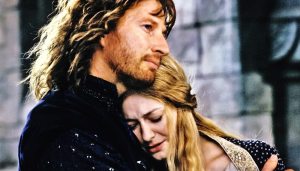This, lovely lurkers, is the first lecturette from now-defunct graduate-level writing and lit course from DU called “Villains, Monsters, and Foes.” In it, I describe the overarching study of the villain character and introduce the three-pronged approach I made for the course: the Monster, Fair-Faiced Villain, and Villain Within. I’d like to hear your comments here in response to the discussion board prompt. I also want to go more into Marina Weber’s concept of the Beast-as-Cyborg, in a post of its own soon.
—————————————
Who Are You?
Archetypes are forms, symbols, or images that have universal meaning and inspire an original model, or prototype.[1]
He is the Napoleon of crime, Watson. He is the organizer of half that is evil and of nearly all that is undetected in this great city. He is a genius, a philosopher, an abstract thinker. He has a brain of the first order. He sits motionless, like a spider in the center of its web, but that web has a thousand radiations, and he knows well every quiver of each of them. He does little himself. He only plans. But his agents are numerous and splendidly organized.[2]
Okay, numerous and well-organized agents, 🙂 this is the idea for the quarter: to explore many samples of the villain archetype, hopefully to inspire your own villain prototype to emerge.
Who is the villain? The antithesis of the hero? Someone with a physical or psychological defect? The hero’s best friend? That sinister bald guy petting his cat? Why does the villain hate the hero so much, and why does he make it a point to get in the hero’s way? What does the villain want?
That’s really the question, isn’t it—as realistic villains normally are after the same goals the heroes are. A non-stereotypical antagonist may not even understand his actions as being necessarily bad, or if so, may feel that his selfish or wicked actions are a means to an end. When discussing the villain Sauron from The Lord of the Rings, Paul Kocher asserts that evil is self-centered; that the essence of the villain is that domination-lust, the desire to be “king of other wills,” the intense (and often paranoid) protection of ego to subordination of all else, and the “lack of imaginative sympathy” is what the hero has that he lacks, which often leads to his downfall.[3]
Think about the overall theme of hubris, or overweening pride, as we explore the three types of villain this quarter:
- The Monster: ugly, deformed, alien, artificial, the “other” in any way
- The Fair-Faced Villain: the one whose villainy is hidden under an attractive façade
- The Villain Within: split-personalities, either literal or figurative
- we’ll also speak briefly about the anti-hero and tragic hero—not quite goodies, not quite baddies?
Who are the already-written characters you love to hate? Why do you think they are effective as characters? Let’s talk about this on our first DB.
————————————
[1] Floyd Rumohr, from Movement for Actors, Nicole Potter, ed. NY: Allworth Press, 2002 (emphasis mine)
[2] Sherlock Holmes, from Arthur Conan Doyle’s The Final Problem
[3] Paul H. Kocher, from Master of Middle Earth, Boston: Houghton Mifflin Co. 1972.



 t at all. I think she is one of the most charming young ladies I ever met, and might have been most useful in such work as we have been doing. She had a decided genius that way: witness the way in which she preserved that Agra plan from all the other papers of her father. But love is an emotional thing, and whatever is emotional is opposed to that true cold reason which I place above all things. I should never marry myself, lest I bias my judgment.”
t at all. I think she is one of the most charming young ladies I ever met, and might have been most useful in such work as we have been doing. She had a decided genius that way: witness the way in which she preserved that Agra plan from all the other papers of her father. But love is an emotional thing, and whatever is emotional is opposed to that true cold reason which I place above all things. I should never marry myself, lest I bias my judgment.”